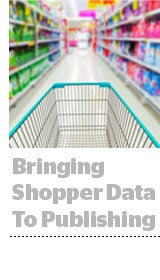CPG advertisers running on Conde Nast properties will be able to target, optimize and measure campaigns using purchase data from Nielsen Catalina Solutions (NCS) beginning in Q1 next year.
The publisher wants to marry its expertise in creative development and sponsored content with an attention to attribution and the bottom line. “If you are not connecting those dots, someone else will prove that out,” said Craig Kostelic, chief business officer for the Lifestyle Collection at Conde Nast.
Conde Nast is the first publisher to connect its own customer data to NCS’ purchase data to its on behalf of advertisers. Conde Nast connected its data and insights platform, Spire, to the Nielsen Catalina API, which it can update daily.
The first two CPG advertisers to use this connection will see their campaigns go live in Q1.
“Nielsen Catalina Solutions is the gold standard for sales lift,” Kostelic said. “Regardless of the type of campaign you are doing – whether the KPI is awareness, purchase intent or cost per acquisition – every marketer is looking for a correlation to sales lift. That is the reality of the world we are living in.”
NCS data is only the latest addition to Spire.
While standard publisher DMPs only segment online behavior, Spire brings in offline data, including proprietary data from its acquisition 1010data. Plus, it includes deterministic data from Conde Nast’s 60 million magazine subscribers and 40 million email newsletter subscribers. Having those home addresses helps Conde Nast create stronger connections to the NCS database compared to other publishers, said Karthic Bala, head of data strategy at Conde Nast.
And because Conde Nast can apply NCS data throughout a CPG advertiser’s campaign – instead of just at the end, when brands historically measure performance – the publisher can optimize campaigns much more quickly.
For instance, Conde Nast can use NCS purchase data at the beginning of a campaign to set up segments – shampoo buyers, for example. Then it can build a predictive model that scores people based on their potential interest in shampoo, and run campaigns on Conde Nast properties where shampoo buyers are most present.
Conde Nast can also use NCS data to optimize an active campaign daily.
And at the end of the campaign, Conde Nast can also do more traditional measurement studies with NCS which account for other factors affecting sales, like broader retail trends, seasonality or a national ad buy on a major TV event.
While the addition of NCS data is new, Conde Nast’s Spire has already been using purchase data from other categories to help optimize campaigns, Bala said.
For example, a campaign for a laptop might seem best suited to Wired, which focuses on technology. But using electronics purchase data and Spire, Conde Nast determined that most of the consumer interest was coming from the artsy, creative readers of Pitchfork as well as the organic foodies reading Bon Appetit. Conde Nast not only optimized the campaign accordingly, it shared those insights back to the client.
“[Marketers] are very interested in where their core audience is, what they are doing and what type of content they are consuming,” Bala said. With the NCS data partnership and Spire, Conde Nast aims to give advertsiers access not only to targeting, optimization and measurement, but also to the type of qualitative insights they can use across their business.














